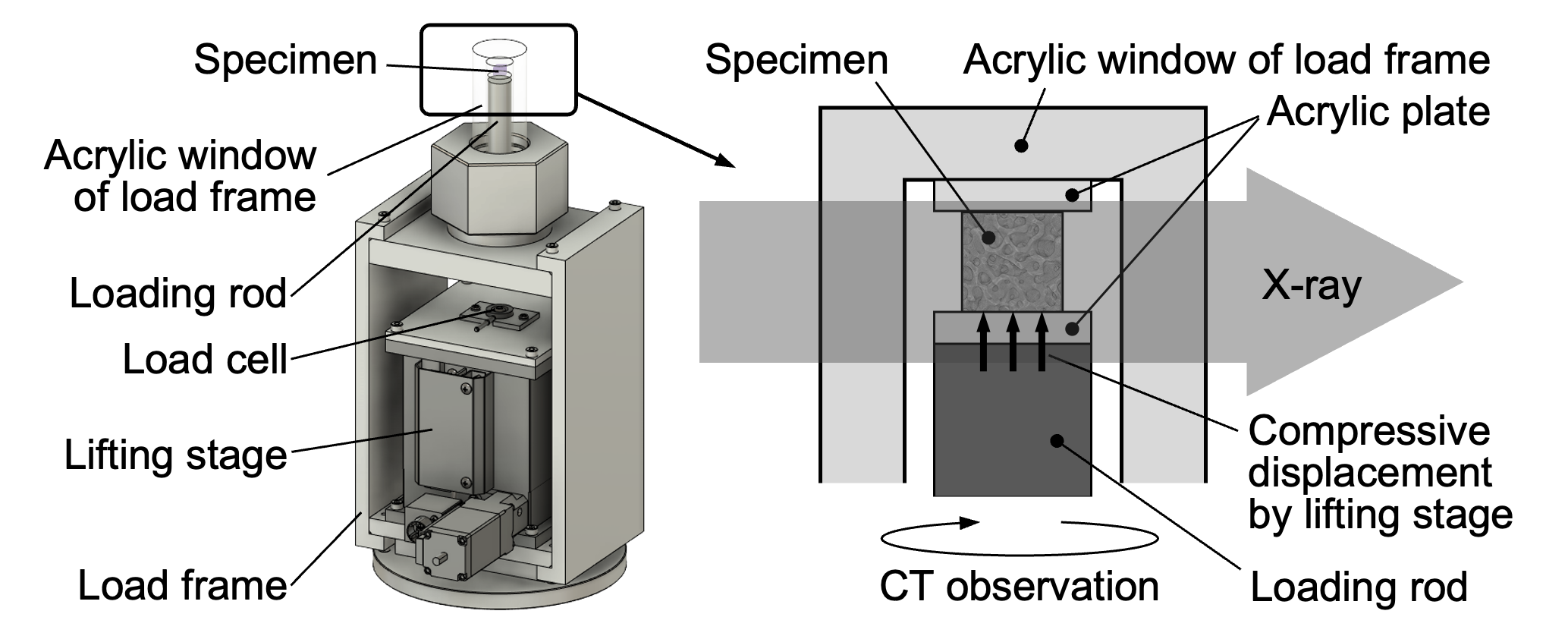Hard Tissue Biomechanics
硬組織のバイオメカニクス
Cancellous stiffness with the microarchitecture of the trabecular network
海綿骨骨梁構造と強度特性
In osteoporosis, there are many fractures in areas where cancellous bone occupies a large proportion. Cancellous bone has a structure in which small beam-like bones called trabeculae are arranged in a three-dimensional structure. The strength of cancellous bone as a whole is less than one-tenth that of cortical bone and is known to depend on the trabecular structure. The relationship between the structural and mechanical properties have not yet been clarified. In this laboratory, we are researching the measurement method of mechanical properties from cancellous bone to trabecular level and the relationship between trabecular network structure and mechanical properties.
骨粗鬆症では,主に海綿骨が多く占める部位での骨折が多く見られます.海綿骨は,骨梁と呼ばれる小さな梁状の骨が3次元編目状に配列した構造です.海綿骨全体の強度は皮質骨の十分の一以下であり,骨梁構造に依存することが知られていますが,一つひとつの骨梁は長さが1mm程度と非常に小さいため骨梁単体の力学的特性は未だ明らかにされていません.本研究室では,海綿骨から骨梁レベルの力学的特性の計測方法や,骨梁ネットワーク構造と力学的特性の関係について研究しています.

Biomimetic Material Design
生体模倣材料設計
Biomimetically mineralized collagen matrix using PILP process
PILPプロセスによる骨模倣石灰化コラーゲンマトリックスの創製
Microscopically, bone is a composite structure consisting of inorganic mineral crystals and organic collagen molecules. In recent years, attempts have been made to develop artificial bone materials that mimic these microscopic composite structures. However, it has not been realized because the details are still unknown. Polymer-induced liquid precursor (PILP) process has attracted attention for the purpose of mineralization of such polymer matrix. According to this method, it is possible to easily generate calcified tissue derived from the polymer matrix structure, and it will contribute to the development of biomaterials that have a hierarchical structure similar to living bones and mechanical functions. In our laboratory, we are conducting research to clarify the relationship between structural and mechanical properties of mineralized bone-like materials fabricated by the PILP process.
微視的には骨は無機成分のミネラル結晶と有機成分のコラーゲン分子からなる複合構造です.近年,これらの微視複合構造を模倣した人工骨材料の開発も試みられてはいますが,コラーゲンの力学的役割、特にアパタイトとの力学的相互作用については複雑かつ微細であり,可視化等による解明も困難であり,その詳細が未だ不明のため,実現には至っていません.このような高分子マトリックスの石灰化を目的として,高分子誘導液体前駆体(PILP)プロセスが注目されています.本手法によれば,高分子マトリックス構造に由来した石灰化組織を簡便に生成することが可能となり,より生体骨に近い階層構造性を持ち,力学的機能を併せ持つバイオマテリアル開発に寄与するものと考えられます.本研究室では、PILPプロセスにより作製した石灰化骨様マテリアルについて,その構造特性と力学的特性の関係について明らかにする研究を行っています.

Biomimetic porous structure by additive manufacturing
付加製造法による骨模倣多孔質材料の作製
Additive manufacturing is a new technology that has many advantages over conventional manufacturing technologies, such as weight reduction and high strength. In the medical field, application to the development of implants based on this technology is expected, and further improvements in performance and reliability are required. In our laboratory, we are conducting additive manufacturing experiments with a 3D printer and investigating the relationship between structural parameters and mechanical properties by mechanical tests of the fabricated porous structure.
付加製造(積層造形)は新たな技術として,従来の製造技術よりも優れた特性として,軽量化や高強度など多くの利点を有しています.医学の分野でも,この技術に基づくインプラント開発への応用が期待されており,さらなる性能の向上や信頼性の向上が求められています.当研究室では,3Dプリンタによる積層造形実験を行い,作製した多孔質構造の力学試験により構造パラメータと力学特性との関係について調査を行っています.

